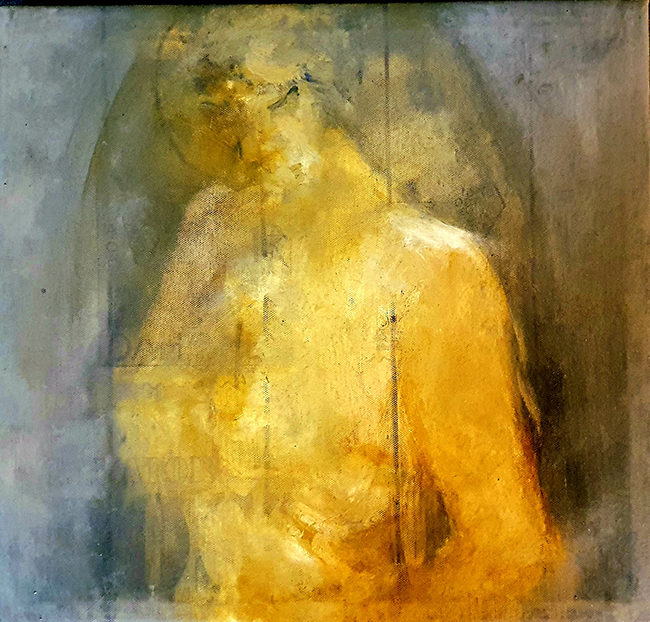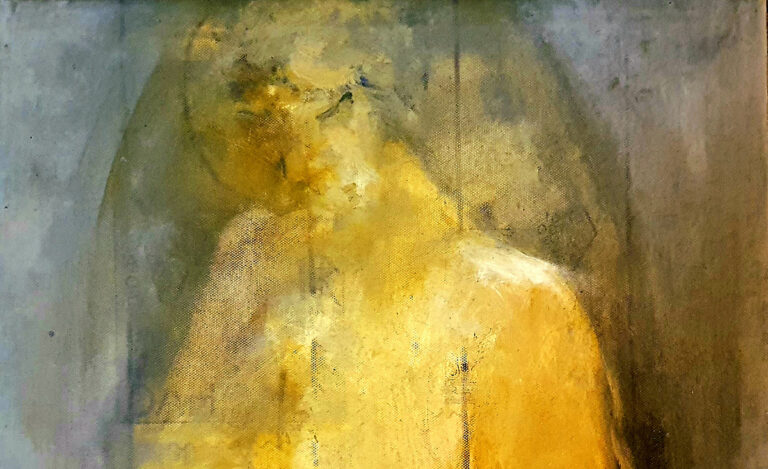Katerina Tsitsela is an artist whose work bridges the realms of painting and engraving, diving deep into the human perception of landscapes. Her art is not just a depiction of physical surroundings but a journey into the human psyche, presenting what she describes as “internal landscapes” or “landscapes of the human soul.” Her paintings often feature dark, introspective scenes where beams of light pierce through, symbolizing the figures that embody our current existential situations as seen through the observer’s eyes.

Tsitsela’s approach to art is deeply psychoanalytical, seeking to uncover the “excessive truth” that lies beyond our material journey. Her use of color and texture plays a crucial role in this exploration. Earthy tones and bold strokes define her world, creating a rough and imposing aesthetic that merges the internal and the abstract.
Her recent works emphasize the rich and complex inner world, using natural materials on a large scale. This choice underscores the importance of the creative process itself, where the artwork becomes a relic of movement and gesture. Tsitsela’s commitment to integrating natural elements into her work highlights her sustained interest in how these materials interact on the canvas, providing a tangible connection to the themes she explores.
Katerina Tsitsela’s art invites viewers to embark on a journey through the landscapes of the human soul. Her unique blend of painting and engraving serves as a medium to explore the depths of human perception and emotional states. Her work is a testament to the power of art to delve into the psyche, revealing the complexities of existence through a visual narrative that is both compelling and thought-provoking.
Tsitsela’s paintings are characterized by their dark, moody atmospheres, where light struggles to break through. This interplay of light and darkness symbolizes the constant battle within the human mind, a struggle to find clarity and understanding amidst chaos. The figures in her paintings are often shrouded in shadows, representing the hidden aspects of our psyche that we grapple with daily. These figures are not just static elements but are dynamic participants in the ongoing narrative of existence, engaging with the viewer on a deeply personal level.
One of the most aspects of Tsitsela’s work is her use of color and texture. The earthy tones she employs create a sense of grounding, connecting the viewer to the raw, primal aspects of human nature. This use of materials is not just a stylistic choice but a deliberate effort to evoke a visceral response from the viewer, drawing them into the emotional landscape she has created.
This approach highlights the interconnectedness of all things, emphasizing that our internal landscapes are influenced by the external environment and vice versa. Her art becomes a reflection of this relationship, a mirror that shows how deeply intertwined our inner and outer worlds truly are.
Her dedication to the creative process is also a significant aspect of her work. Each piece she creates is a testament to the act of creation itself, a relic of the movements and gestures that brought it to life. This focus on process over product adds a layer of depth to her work, reminding viewers that art is not just about the final image but the journey that leads to its creation. This perspective aligns with her psychoanalytical approach, as it emphasizes the importance of understanding the processes that shape our perceptions and experiences.
In summary, Katerina Tsitsela’s art is an exploration of the human condition, using the medium of painting and engraving to delve into the depths of our internal landscapes. Her work is characterized by its dark, introspective atmospheres, dynamic figures, and the tactile quality of natural materials. Through her unique approach, Tsitsela invites viewers to engage with their own inner worlds, offering a visual narrative that is both deeply personal and universally relatable. Her art speaks to the rich inner world that exists within each of us, reminding us of the complex interplay between our internal and external experiences.

